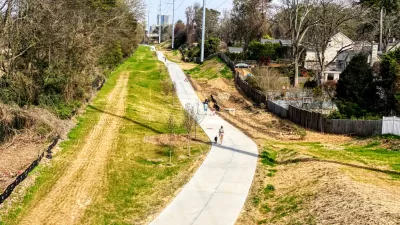A new grant program launched by the Oregon Department of Transportation (ODOT) aims to fill a key gap in the funding available for bike and pedestrian paths.

"The Oregon Department of Transportation has taken the wraps off a new program that will fund off-street path projects across the state," reports Jonathan Maus.
The Oregon Community Paths program, as the new funding program is called, could offer around $19.2 million between federal and state sources through 2024, although that total is subject to some fluctuation depending on budget tightening connected to the economic depression caused by the pandemic.
"ODOT will pull together four funding sources — one from the federal government, three from the State of Oregon — to help plan and construct paths that are not on the roadway right-of-way," according to Maus. "That stipulation is important because Highway Trust Fund, gas tax, and nearly every other major revenue source is legally required to be spent in the right-of-way."
So, for example, safe routes to school that potentially use paths that are not on the roadway, exempted from Highway Trust Fund spending, would be able to seek funding from the new Oregon Community Paths program, according to Maus.
Maus provides additional details on the four kinds of funding fueling the new program, as well as the project types that will be eligible to apply for the new funding. The program website includes more details about the funding schedule. Webinars providing more information about the program are scheduled for August 21 and September 18.
FULL STORY: ODOT says new Community Paths grant program could dish out over $19 million

Alabama: Trump Terminates Settlements for Black Communities Harmed By Raw Sewage
Trump deemed the landmark civil rights agreement “illegal DEI and environmental justice policy.”

Planetizen Federal Action Tracker
A weekly monitor of how Trump’s orders and actions are impacting planners and planning in America.

The 120 Year Old Tiny Home Villages That Sheltered San Francisco’s Earthquake Refugees
More than a century ago, San Francisco mobilized to house thousands of residents displaced by the 1906 earthquake. Could their strategy offer a model for the present?

In Both Crashes and Crime, Public Transportation is Far Safer than Driving
Contrary to popular assumptions, public transportation has far lower crash and crime rates than automobile travel. For safer communities, improve and encourage transit travel.

Report: Zoning Reforms Should Complement Nashville’s Ambitious Transit Plan
Without reform, restrictive zoning codes will limit the impact of the city’s planned transit expansion and could exclude some of the residents who depend on transit the most.

Judge Orders Release of Frozen IRA, IIJA Funding
The decision is a victory for environmental groups who charged that freezing funds for critical infrastructure and disaster response programs caused “real and irreparable harm” to communities.
Urban Design for Planners 1: Software Tools
This six-course series explores essential urban design concepts using open source software and equips planners with the tools they need to participate fully in the urban design process.
Planning for Universal Design
Learn the tools for implementing Universal Design in planning regulations.
Clanton & Associates, Inc.
Jessamine County Fiscal Court
Institute for Housing and Urban Development Studies (IHS)
City of Grandview
Harvard GSD Executive Education
Toledo-Lucas County Plan Commissions
Salt Lake City
NYU Wagner Graduate School of Public Service





























